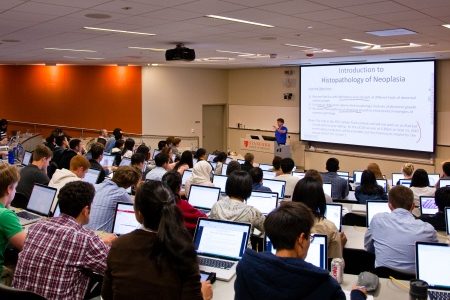Neuroscience in the classroom?
Neuroscientific results are increasingly popular amongst teachers. But what does it mean if children with learning disabilities show less activity in a certain brain area, and can we really use this information in the classroom?
Educators across the world have become increasingly interested in the application of neuroscientific results to the classroom. Unfortunately, the immense popularity of neuroscience has led to dubious but popular commercial applications (Brain Gym and VAK learning styles for example), as well as pervasive ‘neuromyths’ amongst teachers, such as the left brain/right brain myth.
The problem is that it is very difficult for neuroscience to directly inform educational practice. For instance, if it was found that children with reading disabilities show less activity in a certain brain area, how could this information be applied in educational practice? It would be quite inconvenient to implant devices in children’s brains to stimulate activity in the underactivated area (and even then it is not certain that this would actually improve reading scores). In order for neuroscientific results to have practical value, a second step via ‘old-fashioned’ behavioral research is always necessary.
For instance, in the example of reading disabilities, we could compare the underactivated brain area to prior research, to identify the cognitive functions for which this brain area is activated. This allows us to speculate which cognitive subprocess of reading cognition (e.g., recognizing letters) is deficient in children with reading disabilities. However, this is mere speculation until it has been empirically tested in behavioral research. This is exactly where popular interpretations of neuroscientific studies often go wrong: the researchers’ speculative interpretation is declared to be the main finding.
These ‘reverse inferences’, as they are usually called, would not be very problematic if the brain was a simple organ with clearly defined functional divisions. In reality, however, a brain area (which is already hard to define!) is more often than not involved in many different functions. For instance, the left inferior frontal gyrus is activated for phonological processing, verbal fluency, memory encoding, spatial intelligence, and attention, to name a few. This makes it difficult to infer an impaired cognitive process from lower activations in one group of individuals (e.g., our hypothetical children with learning disabilities).
What further complicates the practical application from neuroscience studies, is that in order to actually use the results from our fictional neuroscientific study, we first need to test (by means of behavioral research) if good and bad readers do indeed differ in letter recognition skills, and consequently if a specific training method focusing on improving letter recognition actually improves reading performance.
Because of the costs associated with neuroimaging studies, some critics have argued that we would do better to skip the neuroscience and immediately focus on behavioral research. However, I do not completely agree with this opinion. For one, I think it is always valuable to acquire fundamental knowledge about how the brain works. Although the benefits are sometimes not immediately evident, fundamental research has a history of leading to invaluable practical interventions at a later stage. Moreover, neuroscience can also prove useful if it is seen as a tool to derive new hypotheses to test in behavioral research. Sometimes a research area can become ‘stuck’ in only building on prior research, whereas neuroscience can be very helpful in refocusing research attention to relatively unexplored directions.
For instance, research into developmental dyscalculia now is primarily focusing on a single core deficit that may explain the disorder: processing numerosity. This is a cognitive function that is thought to be located in the parietal cortex. However, neuroimaging studies have shown that for mathematic cognition, activation is also found in many additional neural regions responsible for more general cognitive functions, such as attention and working memory. This finding could lead to the speculation that dyscalculia is influenced by more general cognitive impairments besides numerosity processing. Subsequently, this may eventually result in practical applications if we investigate whether general working memory training can improve mathematical performance.
This example shows how neuroscience can stimulate educational psychologists to research interventions that may benefit teachers and children. However, to justify the relatively high costs of neuroimaging studies, it is crucial that neuroscientists, educational psychologists, and teachers work together to ensure that all sides benefit from each other’s knowledge.





